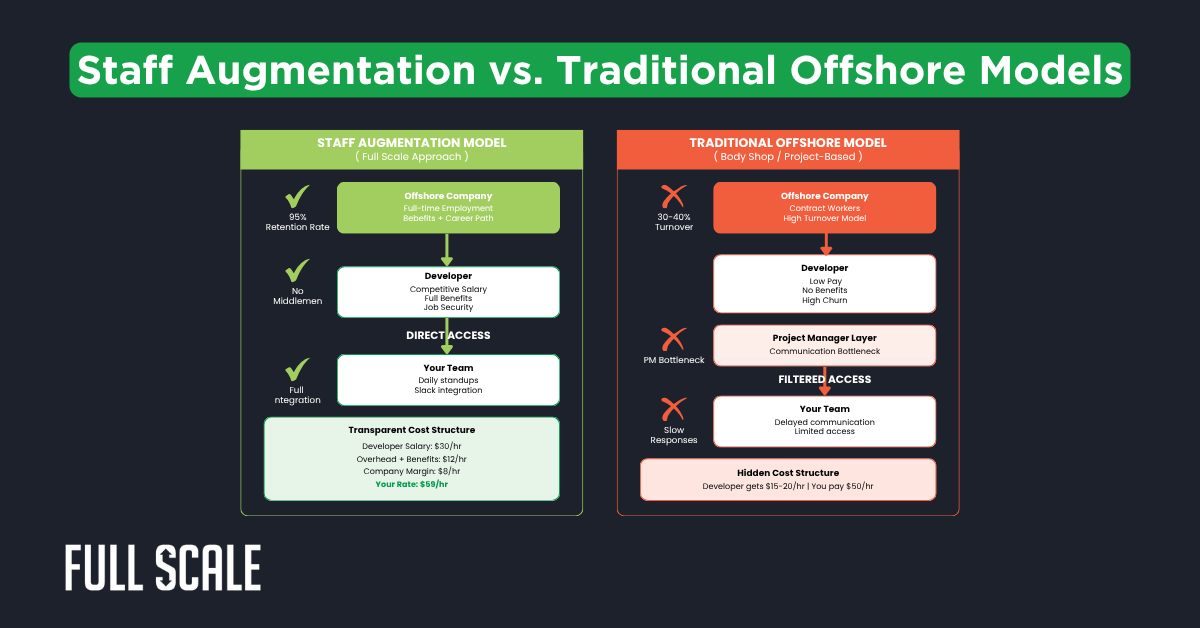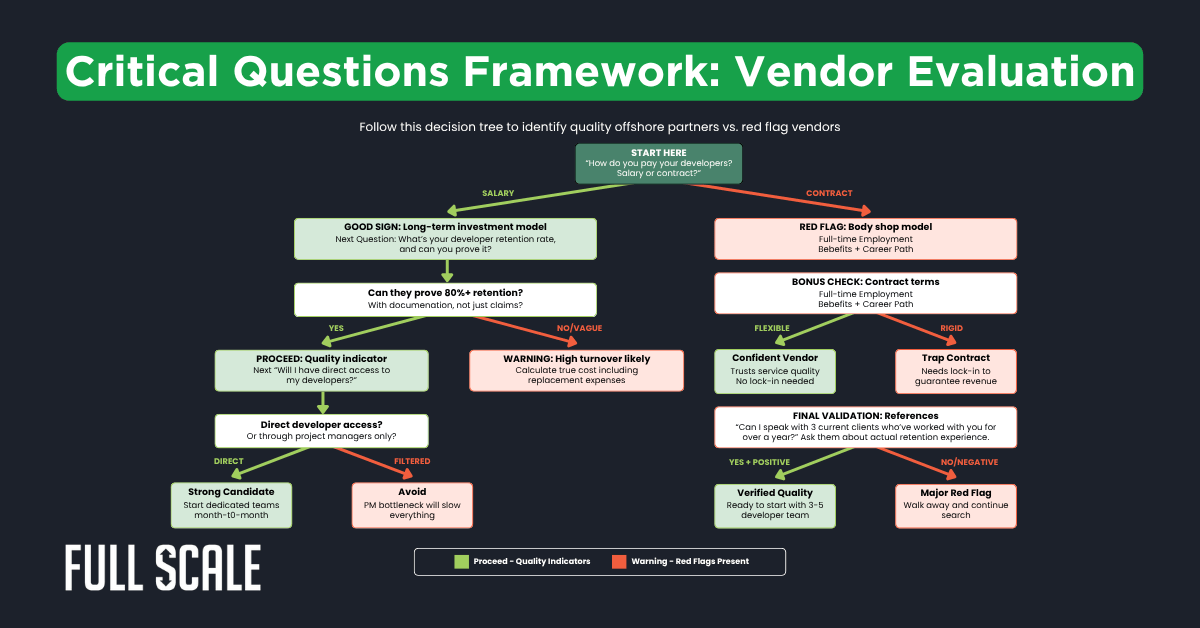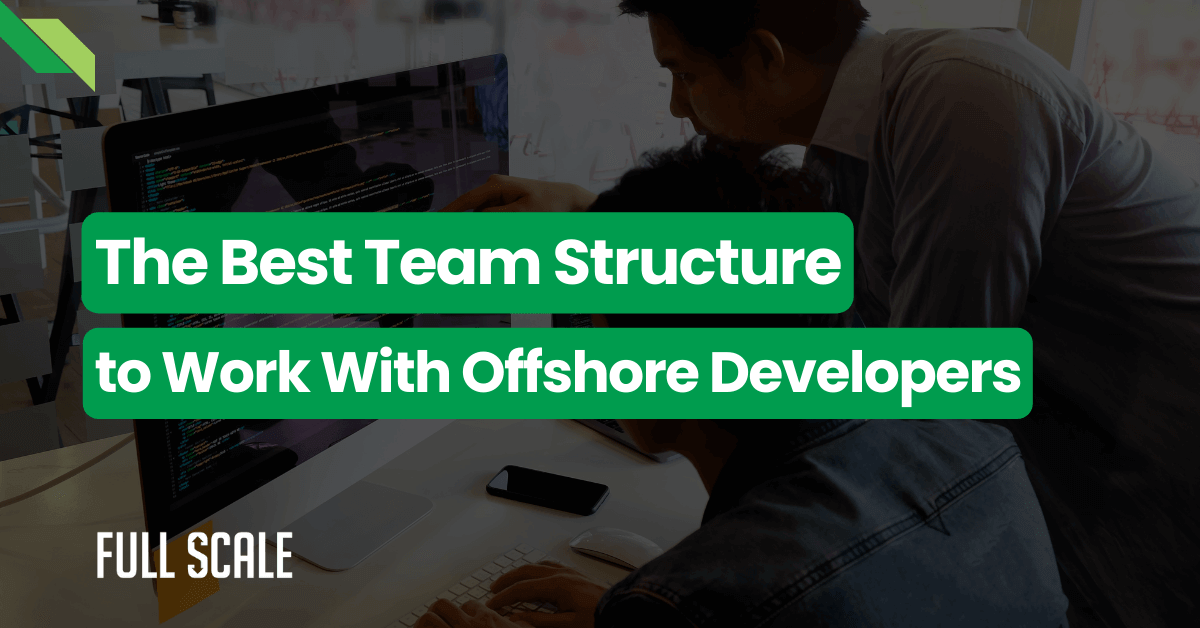Last Updated on 2025-10-14
I’ve worked with over 20 offshore development companies. Most hide the same dirty secrets. The offshore industry runs on information asymmetry. Companies profit when you don’t know how they really operate. When you learn to choose an offshore development company based on reality instead of sales pitches, everything changes.
What You’ll Learn in This Guide
This isn’t theory. This comes from building teams across three continents and watching companies waste millions on bad partnerships. I’ll show you what vendors hide and how to spot the red flags before signing.
The Real Business Models Offshore Companies Use
Most companies don’t understand how offshore vendors actually make money. The business model determines everything about your experience. Let me break down what’s really happening.
What is Offshore Development?
• India (Bangalore, Hyderabad)
• Eastern Europe (Poland, Ukraine)
• Latin America (Argentina, Mexico)
Body Shop: Contract workers
Project Outsourcing: Fixed scope
The Staff Augmentation Model (What We Use)
Staff augmentation companies hire developers as full-time employees. They pay salaries, benefits, and overhead. You pay a markup on that cost.
This model aligns incentives. When developers stay happy and productive, everyone wins. The company invests in retention because replacing developers costs them money.

The math is simple. We pay developers $X, add overhead costs, include our profit margin, and charge you the total. You get stability. We get predictable revenue. The developer gets career growth.
The Body Shop Model (High Turnover by Design)
Body shops treat developers as interchangeable units. They hire cheap, bill high, and churn constantly. The bigger the gap between what they pay and what they charge, the more they profit.
These companies don’t care about retention. They’re optimized for volume. Replace one developer? They have ten more waiting. You bear all the costs of turnover.
The incentive structure is broken. Every time you need to replace a developer, they profit. Every onboarding cycle generates new revenue. Your project delays make them money.
The Project-Based Outsourcing Model
Project outsourcing companies bid fixed prices for defined scopes. They profit by cutting corners. Fewer hours and cheaper developers mean higher margins.
This creates adversarial relationships. You want more features. They want fewer hours. You want senior developers. They want to use juniors. Every request becomes a negotiation.
Change orders are their real profit center. The initial bid gets your signature. Scope changes generate premium rates. Before you know it, you’ve paid triple the original estimate.
How Margins Really Work
Most offshore companies operate on 40-60% gross margins. If you’re paying $50/hour, the developer sees $20-30/hour. The rest covers overhead and profit.
Offshore Developer True Cost Calculator
Calculate the real cost difference between high-turnover and high-retention offshore models
Traditional Offshore Model
Staff Augmentation Model
Your Potential Savings
Cost Breakdown Details
Calculate actual developer compensation vs. your hourly rate across different company models.
High margins aren’t automatically bad. The question is what you get for that markup. Staff augmentation companies reinvest in benefits and retention. Body shops pocket the difference.
When you choose an offshore development company, understand their business model first. It determines whether your interests align or conflict.
The Hidden Costs in Offshore Development Pricing
Offshore companies advertise low rates. Then hidden costs destroy your budget. Here’s what they don’t mention in sales calls.
Replacement Costs Nobody Mentions
Most offshore companies have 30-40% annual developer turnover. Every replacement costs you 6-8 weeks of productivity. That “cheap” developer becomes expensive fast.
Calculate the real cost. Loss of institutional knowledge. Ramp-up time for the replacement. Code review and knowledge transfer. Management overhead is coordinating the transition.
Developer Turnover: The Real Cost Over Time
Year-by-year comparison showing cumulative impact of high vs. low turnover rates
Cost Assumptions
| Year | Model | Base Development Cost | Replacements | Replacement Cost | Lost Productivity | Management Overhead | Annual Total |
|---|---|---|---|---|---|---|---|
| 1 | Traditional Offshore | $312,000 | 0.9 devs | $13,500 | $7,200 | $46,800 | $379,500 |
| Staff Augmentation | $312,000 | 0.15 devs | $2,250 | $1,200 | $15,600 | $331,050 | |
| 2 | Traditional Offshore | $312,000 | 0.9 devs | $13,500 | $7,200 | $46,800 | $379,500 |
| Staff Augmentation | $312,000 | 0.15 devs | $2,250 | $1,200 | $15,600 | $331,050 | |
| 3 | Traditional Offshore | $312,000 | 0.9 devs | $13,500 | $7,200 | $46,800 | $379,500 |
| Staff Augmentation | $312,000 | 0.15 devs | $2,250 | $1,200 | $15,600 | $331,050 | |
| 4 | Traditional Offshore | $312,000 | 0.9 devs | $13,500 | $7,200 | $46,800 | $379,500 |
| Staff Augmentation | $312,000 | 0.15 devs | $2,250 | $1,200 | $15,600 | $331,050 | |
| 5 | Traditional Offshore | $312,000 | 0.9 devs | $13,500 | $7,200 | $46,800 | $379,500 |
| Staff Augmentation | $312,000 | 0.15 devs | $2,250 | $1,200 | $15,600 | $331,050 |
5-Year Cumulative Impact
Total Cost Difference
Savings over 5 years with high retention
Developer Replacements
Fewer replacements needed
Lost Productivity Hours
Hours saved from reduced turnover
Management Time Saved
Reduced overhead from stable teams
Year-by-year comparison showing cumulative costs of high turnover vs. low turnover.
We maintain 95% retention rates. That’s not luck. We pay developers well, provide career paths, and create genuine employment relationships. It costs more upfront but saves you money long-term.
The Management Layer You Didn’t Know You’re Paying For
Traditional offshore companies insert project managers between you and developers. You’re paying for those project managers. They’re baked into your hourly rate.
These PMs act as intermediaries because direct communication “doesn’t scale.” Translation: their developers can’t communicate effectively. The PM layer exists to hide that problem.
Every message gets filtered. Every request gets translated. Every decision gets delayed. You’re paying $10-15/hour for this communication bottleneck.
When you choose an offshore development company with direct access, you eliminate this waste. Your developers join your Slack. They attend your standups. No intermediaries.
Contract Minimums and Commitment Traps
Long-term contracts look attractive on paper. Lower rates in exchange for 12-month commitments. But flexibility costs more than any discount saves.
Your needs change. Projects get cancelled. Priorities shift. Being locked into developers you don’t need wastes more than you saved on the discount.
We offer month-to-month agreements. No long-term commitments. You can scale up or down based on actual needs. That flexibility is worth more than discounted rates with rigid contracts.
Infrastructure and Overhead Costs
Some vendors charge separately for infrastructure. Office space, equipment, and software licenses. These costs should be included in hourly rates, but many companies itemize them for higher total billing.
Review invoices carefully. If you see charges for “infrastructure,” “equipment rental,” or “facility costs,” you’re being nickel-and-dimed. Quality companies include operational overhead in their base rates.
The Time Zone Overhead Nobody Calculates
Working across time zones creates hidden costs. Delayed feedback cycles. Meetings at inconvenient times. Questions sitting unanswered for 12 hours.
Some time zone differences are manageable. The Philippines has a 4-5 hour overlap with the US West Coast, and Eastern Europe has 2-3 hours with the US East Coast. Choose regions that allow real-time collaboration for critical projects.
When you choose an offshore development company, calculate the total cost of ownership. The lowest hourly rate usually becomes the highest actual cost.
Questions Vendors Hope You Never Ask
Smart questions expose weak vendors immediately. I’ve seen vendors squirm when clients ask these. Here’s what you need to ask before signing anything.
About Their Business Model
Ask: “How do you pay your developers? Salary or contract?”
This reveals everything. Salaried employees indicate long-term investment. Contract workers indicate body shop operations. Their answer tells you whose interests they prioritize.
Ask: “What’s your gross margin on my engagement?”
Legitimate companies answer this. If they won’t disclose their margin structure, they’re hiding something. Transparency indicates alignment.
About Developer Retention
Ask: “What’s your retention rate, and can you prove it?”
Don’t accept vague answers. Request specific numbers. Ask for documentation. High-retention companies proudly share these metrics.
Ask: “What happens if a developer leaves? Who pays for the transition?”
This reveals risk allocation. Quality companies absorb replacement costs. Body shops pass everything to you.

About Developer Access
Ask: “Will I have direct access to my developers?”
If they say “through your dedicated project manager,” run away. You’re buying a communication bottleneck.
Ask: “Can my developers join our Slack and daily standups?”
Direct integration is non-negotiable for modern development. Any resistance indicates outdated models.
About Contract Terms
Ask: “Can I start with a dedicated team on a month-to-month basis?”
Confident companies offer flexible month-to-month terms after 30-60 days. Desperate companies demand long-term commitments up front. Skip pilot projects entirely—they fail 67% of the time by testing handicapped scenarios.
Ask: “What are your exact termination terms?”
30-day notice periods are standard. Anything longer traps you. Early termination penalties indicate they don’t trust their service quality.
About References
Ask: “Can I speak with three current clients who’ve worked with you for over a year?”
Recent clients might still be in honeymoon phases. Long-term clients know the real story. If they can’t provide satisfied multi-year clients, that’s your answer.
Ask specific questions to references: “How many developers have you replaced? What’s been your actual retention experience? Any hidden costs that surprised you?”
These questions help you choose an offshore development company based on facts instead of marketing claims.
Contract Red Flags That Trap Companies
Bad contracts create expensive problems. These terms signal vendors who prioritize their interests over yours. Watch for these red flags.
Long Commitment Periods
Any contract requiring more than two months upfront is excessive. Quality vendors don’t need to trap you. They’re confident you’ll stay because the service is good.
12-month minimums are especially problematic. Your needs change. Projects pivot. Being locked in costs more than any discount saves.
When you choose an offshore development company, insist on month-to-month terms after a brief 30-60 day initial period. Flexibility matters more than rate discounts. Don’t waste time on pilot projects—commit to properly resourced, dedicated teams from day one, or don’t start at all.
Aggressive Non-Compete Clauses
Some vendors prohibit you from hiring “their” developers. This reveals their business model. If they view developers as their assets to protect, they’re not aligned with your success.
We encourage clients to hire our developers permanently. If someone becomes mission-critical, take them in-house. We’ll find you a replacement. Your success matters more than protecting our inventory.
Vague Performance Standards
Contracts without specific performance standards create problems. “Best effort” clauses mean nothing. You need defined quality metrics and consequences for missing them.
Look for specific SLAs. Response times. Code quality standards. Performance guarantees. Without these, you have no recourse when things go wrong.
Hidden Fee Structures
Watch for contracts with “additional charges” sections. Infrastructure fees. Management fees. Communication fees. These add 20-30% to your quoted rates.
All operational costs should be included in hourly rates. If you see itemized add-ons, you’re looking at a company optimized for billing complexity rather than service delivery.
Restrictive IP Clauses
Your code is your property. Period. Any contract that suggests shared IP ownership or licensing complications should be rejected immediately.
US-based contracts provide clear IP protection. Foreign contracts often include ambiguous clauses about work-for-hire and IP rights. This is non-negotiable when you choose an offshore development company.
Contract Red Flags: Warning Signs Checklist
Review your vendor contracts against these critical warning signs before signing
How to use this checklist: Check each box if you encounter this red flag in a vendor contract. The more boxes checked, the higher the risk. Any single red flag should trigger serious concerns. Multiple red flags mean you should walk away.
✓ What Good Contracts Look Like
The Developer Quality Problem
Most offshore companies claim they hire "senior" developers. The definition of "senior" varies wildly. Here's how to assess actual quality before committing.
Testing Technical Skills
Request specific technical assessments for your stack. Not generic coding tests. Real problems you're currently solving.
Watch for vendors who resist technical evaluation. Quality companies welcome it. They're confident in their developers' abilities.
We let potential clients interview our developers directly. Technical screening, pair programming sessions, and code reviews. You should know exactly who's joining your team.
Communication Standards
Technical skills matter less when communication fails. Test English proficiency directly. Video calls, not just written messages.
Many offshore companies hire developers with strong coding skills but weak English. They compensate with project managers. This creates the communication bottlenecks I mentioned earlier.
When you choose an offshore development company, prioritize both technical ability and communication skills. You can't separate the two in modern software development.
Portfolio and Past Work
Ask to see actual code repositories from previous projects. Not screenshots or descriptions. Real GitHub repos or code samples.
Quality developers have public portfolios. They contribute to open source. They maintain personal projects. If a vendor can't show you real code from their team, question their technical standards.
Continuous Learning and Development
Ask about professional development programs. How do they help developers grow? What training do they provide?
We invest heavily in developer education. Conference attendance. Course reimbursement. Internal training programs. Developers stay because they're growing their skills.
Body shops don't invest in development. Developers are interchangeable parts. This explains their high turnover and declining skill levels.
Cultural Fit and Team Integration
Technical skills aren't enough. Your offshore developers need to integrate with your existing team. Cultural alignment determines success.
Work Style Compatibility
Some cultures favor indirect communication. Others prefer directness. Some avoid saying "no" to requests. Others challenge assumptions freely.
Understand these differences before you choose an offshore development company. The Philippines tends toward US-compatible work styles. Eastern Europe brings more direct communication. India often has more hierarchical structures.
None are inherently better. But misalignment creates friction. We screen for cultural fit as carefully as technical skills.
Time Zone Realities
Time zone overlap determines collaboration quality. Calculate realistic overlap hours for your team's schedule.
Time Zone Overlap Comparison: Major Offshore Regions
Choose the right location based on your team's collaboration needs and working hours
Why Time Zone Overlap Matters
Real-time collaboration requires 4+ hours of daily overlap for effective standups, quick questions, and synchronous work. Less overlap forces asynchronous workflows. More overlap enables seamless integration but may reduce cost savings. Choose based on your team's actual collaboration needs, not just pricing.
| Region | US East Coast Overlap | US West Coast Overlap | Best Use Cases | Key Considerations |
|---|---|---|---|---|
| Philippines Manila / Cebu |
1-2 hours daily
MODERATE
5:00 AM - 7:00 AM EST overlap |
4-5 hours daily
EXCELLENT
8:00 AM - 1:00 PM PST overlap |
Ideal for West Coast companies needing strong overlap for daily standups and real-time collaboration. Works well for East Coast teams comfortable with early morning or late evening check-ins. |
|
| Eastern Europe Poland / Ukraine / Romania |
2-3 hours daily
GOOD
9:00 AM - 12:00 PM EST overlap |
0-1 hours daily
MODERATE
12:00 PM - 1:00 PM PST overlap |
Best for East Coast companies needing morning overlap. Strong technical talent pool. Good for projects requiring specialized skills. Less suitable for West Coast teams needing real-time collaboration. |
|
| India Bangalore / Hyderabad |
0-1 hours daily
MODERATE
7:00 AM - 8:00 AM EST overlap |
3-4 hours daily
GOOD
6:00 AM - 10:00 AM PST overlap |
Large talent pool with competitive pricing. Works for asynchronous workflows or West Coast morning overlap. Requires strong processes for distributed collaboration. Better for established projects than rapid iteration. |
|
| Latin America Argentina / Colombia / Mexico |
6-8 hours daily
EXCELLENT
9:00 AM - 5:00 PM EST overlap |
6-8 hours daily
EXCELLENT
9:00 AM - 5:00 PM PST overlap |
Maximum overlap for both coasts. Ideal for projects requiring constant real-time collaboration. Cultural similarities ease communication. Good for rapid iteration and agile workflows requiring daily sync. |
|
Recommendations by Your Location and Needs
West Coast Teams
Best Choice: Philippines
4-5 hours daily overlap enables morning standups, real-time collaboration, and quick feedback cycles. Cost-effective with strong retention rates.
East Coast Teams
Best Choice: Eastern Europe or Latin America
Eastern Europe for specialized technical skills with morning overlap. Latin America for maximum overlap if budget allows.
Asynchronous Workflows
Best Choice: Philippines or India
When real-time collaboration isn't critical, maximize cost savings. Philippines offers better retention and communication quality.
Rapid Iteration Projects
Best Choice: Latin America or Philippines (West Coast)
Projects requiring daily sync, quick decisions, and frequent communication benefit from maximum overlap regardless of location.
Four-hour overlap enables daily standups and quick synchronous communication. Less than that forces asynchronous workflows. More than six hours of overlap may indicate less cost savings.
Integration Practices
Your offshore developers should feel like team members, not vendors. This requires intentional integration practices.
Include them in all relevant meetings. Not just standups. Sprint planning, retros, architecture discussions. Full team participation.
Invite them to company events and social activities, even virtually. Recognition programs. Team building. These create genuine belonging.
When you choose an offshore development company, evaluate its integration philosophy. Do they encourage full team membership or maintain vendor separation?
Starting Smart: Why Pilot Projects Waste Resources
Most consultants recommend pilot projects to minimize offshore risk. They're wrong. Pilot projects fail 67% of the time because they're designed to fail.
Here's what happens with pilot projects. You assign low-priority work that doesn't reflect real capabilities. You allocate minimal resources. Your team knows it's temporary, so commitment drops. Stakeholders barely engage because it's "just a test."
You're not evaluating offshore capabilities. You're testing a handicapped version guaranteed to underperform.
The Dedicated Team Approach
When you choose an offshore development company, commit to doing it right from day one. Start with a properly resourced dedicated team, not an underfunded experiment.
A proper offshore team includes 3-5 developers minimum. Senior and mid-level developers, not just juniors. Dedicated QA resources. Direct integration into your workflows from the start.
Assign them real strategic work. Not throwaway tasks. Actual features that matter to your business. This is the only way to evaluate true capabilities.
Full Integration from Day One
Your offshore team integrates completely from the start. Daily standups. Slack access. Code reviews. Sprint participation. Full stakeholder engagement.
This isn't a "test phase." This is your actual development team. Treat them accordingly. When you choose an offshore development company using this approach, you see real capabilities immediately.
No ramp-up period where they "prove themselves" on unimportant work. No waiting to assign critical tasks. They're either good enough for real work or they're not good enough at all.
Month-to-Month Flexibility Replaces Pilots
You don't need pilot projects when you have month-to-month contracts. Start with proper resources and real work. If performance isn't meeting standards after 30-60 days, exit the relationship.
This approach actually reduces risk compared to pilots. You're evaluating real capabilities under real conditions. Not artificial constraints that hide problems until it's too late.
When you choose an offshore development company, insist on month-to-month terms after a brief initial period. Companies confident in their quality offer this. Those demanding long commitments reveal they don't trust their own service.
Success Metrics That Matter
Define clear success criteria before starting. Code quality standards. Communication responsiveness. Task completion velocity. Integration smoothness.
Measure performance on strategic work, not throwaway tasks. Real work reveals real capabilities. If they can't handle your important projects from day one, no pilot project would have revealed that either.
The right vendor meets expectations immediately. The wrong vendor wastes months regardless of whether you start with a pilot or a dedicated team. Choose wisely and commit properly from the start.
Vendor Comparison Framework
Evaluating multiple vendors requires a systematic comparison. Here's how to choose an offshore development company using structured evaluation.
Core Evaluation Criteria
Rate each vendor on these dimensions. Use a 1-10 scale for objectivity.
Developer Quality
- Technical assessment results
- Communication skills
- Portfolio quality
- Past client feedback
Business Model Alignment
- Retention rates
- Margin transparency
- Contract flexibility
- Risk allocation
Operational Maturity
- Integration capabilities
- Infrastructure quality
- Communication tools
- Project management approach
Offshore Vendor Comparison Scorecard
Systematically evaluate and compare vendors across key criteria with weighted scoring
How to Use This Scorecard
Rate each vendor on a scale of 1-10 for each criterion (10 = excellent, 1 = poor). Scores are automatically weighted based on importance. Higher total scores indicate better overall fit. Focus on objective evidence rather than sales presentations when scoring.
Enter Vendor Names
| Evaluation Criteria | Vendor A | Vendor B | Vendor C |
|---|---|---|---|
| Developer Quality (40% weight) | |||
|
Technical Skills
Coding assessment results, portfolio quality, technology expertise
|
|||
|
Communication Skills
English proficiency, clarity in technical discussions, responsiveness
|
|||
|
Past Work Quality
Code samples, GitHub portfolios, client references, project outcomes
|
|||
| Business Model Alignment (35% weight) | |||
|
Retention Rate
Documented retention rate (85%+ is good, 90%+ is excellent)
|
|||
|
Pricing Transparency
Clear margin disclosure, no hidden fees, straightforward pricing
|
|||
|
Contract Flexibility
Month-to-month terms, reasonable notice period, no trap clauses
|
|||
|
Risk Allocation
Who pays for replacements, IP protection, liability terms
|
|||
| Operational Maturity (25% weight) | |||
|
Direct Access Model
Developers join Slack/standups directly, no PM intermediaries
|
|||
|
Infrastructure Quality
Reliable internet, modern equipment, backup systems, security
|
|||
|
Integration Capabilities
Experience with agile workflows, version control, CI/CD tools
|
|||
| TOTAL WEIGHTED SCORE | 0 |
0 |
0 |
Complete Vendor Rankings
Reference Check Questions
References reveal that truth sales calls hide. Ask these specific questions:
How long have you worked with this vendor? How many developers have you gone through in that time? What's your actual retention experience?
Have you encountered any surprise costs? Hidden fees? Unexpected charges? What does your all-in cost look like compared to initial quotes?
Do your developers truly integrate with your team? Can they communicate effectively in real-time? Any communication bottlenecks or frustrations?
Red Flag Scoring
Some issues should disqualify vendors immediately. Create a mandatory criteria list:
Must offer month-to-month contracts after the trial period. Must provide direct developer access without PM intermediaries. Must demonstrate 80%+ retention rates with documentation. Must use US-based contracts for IP protection.
Any vendor failing mandatory criteria gets eliminated, regardless of other strengths.
Making the Final Decision
Choose based on alignment, not just cost. The cheapest option usually becomes the most expensive. The most expensive doesn't guarantee quality.
Look for vendors who transparently explain their model, welcome tough questions, and demonstrate long-term client relationships. These indicators matter more than hourly rates.
When you choose an offshore development company, trust your evaluation framework. Don't let charm or aggressive sales tactics override your systematic assessment. Start with a properly resourced dedicated team on month-to-month terms, not underfunded pilot projects that fail 67% of the time.
What Great Partnerships Actually Look Like
After working with 20+ offshore companies, I know what separates excellent partnerships from problematic ones. Here are the patterns that matter.
Mutual Investment
Great vendors invest in your success. They learn your business. They understand your constraints. They suggest improvements proactively.
They also expect you to invest in the relationship. Clear requirements. Timely feedback. Including them in relevant discussions. Partnership requires effort from both sides.
Transparent Communication
Problems happen. Great vendors discuss issues openly rather than hiding them. Developer performance concerns. Technical challenges. Schedule risks.
Transparency enables collaborative problem-solving. When you choose an offshore development company that communicates honestly, you can address issues before they become crises.
Continuous Improvement
Strong partnerships evolve. Processes improve. Communication gets smoother. Quality increases. Both parties learn and adapt.
Static relationships indicate nobody's trying to improve. Growth, even small incremental improvements, signals healthy partnerships.
Long-Term Thinking
Great vendors think beyond the current contract. They anticipate your future needs. They invest in developing skills you'll need next quarter, not just today.
They also communicate honestly about fit. If they're not the right solution for a particular need, they say so. This long-term thinking builds trust.
Common Myths About Offshore Development
The offshore industry has earned some of its bad reputation. But many beliefs about offshore development are outdated or simply wrong.
Myth: Offshore Always Means Poor Quality
This generalizes from bad experiences. Yes, many offshore companies deliver poor quality. But plenty of US developers do too.
Quality depends on hiring standards, not location. When you choose an offshore development company with rigorous vetting and strong retention, you get excellent developers.
We've placed developers who became technical leads at their client companies. Location doesn't determine capability.
Myth: Communication Is Always Problematic
This was true ten years ago. English proficiency has improved dramatically in major offshore markets. Technology has improved too.
Slack, Zoom, and modern collaboration tools eliminate most communication barriers. We screen specifically for communication skills. Our developers participate in standups as effectively as US-based team members.
Myth: Time Zones Make Collaboration Impossible
Large time zone differences do create challenges. But "impossible" overstates the problem.
Four hours of daily overlap enables synchronous communication when needed. Asynchronous work is increasingly normal even for colocated teams. Modern development practices accommodate distributed teams effectively.
Myth: Offshore Is Just for Cost Savings
Cost matters. But access to talent matters more. The US tech talent shortage is real. Offshore development expands your hiring pool dramatically.
Many companies choose offshore development to access specialized skills unavailable locally. The cost savings are a bonus, not the primary motivation.
Myth: You Lose Control with Offshore Teams
This depends entirely on the model. Yes, traditional project outsourcing creates control problems. The vendor manages the team. You influence through change requests.
Staff augmentation gives you direct control. Offshore developers report to you. They work in your systems. They follow your processes. You have the same control as with local employees.
When you choose an offshore development company using the staff augmentation model, control issues disappear.
The Full Scale Difference
We built Full Scale because we experienced these problems firsthand. Traditional offshore development frustrated us. We knew there was a better way.
Our Approach
We treat developers as full-time employees, not contractors. Competitive salaries. Full benefits. Career development. This creates the 95% retention rate that makes everything else work.
You get direct access. Your developers join your Slack, attend your meetings, integrate completely. No project managers as intermediaries. No communication bottlenecks.
We use month-to-month contracts. No long-term commitments. We're confident in our service quality. You'll stay because it works, not because a contract traps you.
Why This Matters for You
Choosing the right offshore development company determines whether offshore development succeeds or fails for your organization. The wrong choice wastes money and delays projects. The right choice accelerates development and improves quality.
We've helped over 60 tech companies build effective offshore teams. Not because we're cheaper. Because our model actually works.

The Numbers That Matter
95% developer retention rate. 300+ pre-vetted specialists. 60+ satisfied clients. These aren't marketing claims. They're the results of aligning incentives correctly.
When developers stay, your costs decrease. Knowledge accumulates. Velocity increases. Quality improves. Everything gets easier over time.
Build Your Offshore Team Now
How much should I expect to pay for quality offshore developers?
Senior developers cost $40-65/hour depending on specialization. Junior developers range $25-40/hour. Rates below $25/hour generally indicate quality or retention problems. Remember, hourly rate matters less than total cost of ownership including turnover costs.
What retention rate should I expect from a quality offshore company?
Industry average is 60-70% annual retention. Quality companies achieve 85-90%. We maintain 95% because we treat developers as long-term employees, not disposable contractors. Anything below 80% creates expensive turnover problems.
What contract terms should I accept when I choose an offshore development company?
Month-to-month agreements after a brief initial period (30-60 days maximum). 30-day notice for termination. No hidden fees. US-based contracts for IP protection. Clear performance standards. Anything more restrictive indicates the vendor lacks confidence in their service quality. Skip pilot projects entirely—they fail 67% of the time and waste resources testing handicapped versions of offshore capabilities.
What's the real cost of high developer turnover?
Replacement costs include 6-8 weeks of ramp-up time, knowledge loss, technical debt, and management overhead. These hidden costs often double your effective hourly rate. A $30/hour developer with high turnover costs more than a $50/hour developer with 95% retention.
How do I start working with an offshore company without risk?
Use month-to-month contracts with a properly resourced dedicated team from day one. Start with 3-5 developers on real strategic work, not throwaway test projects. Integrate them fully into your Slack and standups immediately. Evaluate performance on actual business-critical tasks for 30-60 days. Scale if quality meets standards. Exit if it doesn't. Pilot projects fail 67% of the time because they test handicapped versions with minimal resources and low-priority work. This approach evaluates real capabilities under real conditions.

Matt Watson is a serial tech entrepreneur who has started four companies and had a nine-figure exit. He was the founder and CTO of VinSolutions, the #1 CRM software used in today’s automotive industry. He has over twenty years of experience working as a tech CTO and building cutting-edge SaaS solutions.
As the CEO of Full Scale, he has helped over 100 tech companies build their software services and development teams. Full Scale specializes in helping tech companies grow by augmenting their in-house teams with software development talent from the Philippines.
Matt hosts Startup Hustle, a top podcast about entrepreneurship with over 6 million downloads. He has a wealth of knowledge about startups and business from his personal experience and from interviewing hundreds of other entrepreneurs.




